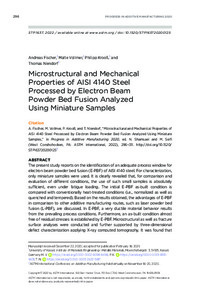| dc.date.accessioned | 2023-10-18T07:27:36Z | |
| dc.date.available | 2023-10-18T07:27:36Z | |
| dc.date.issued | 2022-02-26 | |
| dc.identifier | doi:10.17170/kobra-202310178866 | |
| dc.identifier.uri | http://hdl.handle.net/123456789/15112 | |
| dc.language.iso | eng | |
| dc.publisher | ASTM International | |
| dc.rights | Urheberrechtlich geschützt | |
| dc.rights.uri | https://rightsstatements.org/page/InC/1.0/ | |
| dc.subject | electron beam melting | eng |
| dc.subject | additive manufacturing | eng |
| dc.subject | microstructure | eng |
| dc.subject | heat treatment | eng |
| dc.subject | mechanical performance | eng |
| dc.subject | structural integrity | eng |
| dc.subject.ddc | 620 | |
| dc.title | Microstructural and Mechanical Properties of AISI 4140 Steel Processed by Electron Beam Powder Bed Fusion Analyzed Using Miniature Samples | eng |
| dc.type | Konferenzveröffentlichung | |
| dcterms.abstract | The present study reports on the identification of an adequate process window for electron beam powder bed fusion (E-PBF) of AISI 4140 steel. For characterization, only miniature samples were used. It is clearly revealed that, for comparison and evaluation of different conditions, the use of such small samples is absolutely sufficient, even under fatigue loading. The initial E-PBF as-built condition is compared with conventionally heat-treated conditions (i.e., normalized as well as quenched and tempered). Based on the results obtained, the advantages of E-PBF in comparison to other additive manufacturing routes, such as laser powder bed fusion (L-PBF), are discussed. In E-PBF, a very ductile material behavior results from the prevailing process conditions. Furthermore, an as-built condition almost free of residual stresses is established by E-PBF. Microstructural as well as fracture surface analyses were conducted and further supported by three-dimensional defect characterization applying X-ray computed tomography. It was found that the microstructural appearance of the as-built condition is affected most severely by the relatively sluggish cooling after the uppermost layer is finished. Thus, many issues related to L-PBF processing of carbon steels such as AISI 4140 do not prevail in E-PBF. The results obtained by mechanical testing clearly reveal that the remaining process-related volume defects can be compensated to a certain extent in the ductile as-built state. Consequently, the non-heat-treated, as-built condition is characterized by fatigue properties similar to those of post-treated AISI 4140. The latter, however, is characterized by superior strength under monotonic loading. | eng |
| dcterms.accessRights | open access | |
| dcterms.creator | Fischer, Andreas | |
| dcterms.creator | Vollmer, Malte | |
| dcterms.creator | Krooß, Philipp | |
| dcterms.creator | Niendorf, Thomas | |
| dc.publisher.place | West Conshohocken | |
| dc.relation.doi | doi:10.1520/STP163720200125 | |
| dc.subject.swd | Elektronenstrahlschmelzen | ger |
| dc.subject.swd | Rapid Prototyping <Fertigung> | ger |
| dc.subject.swd | Mikrostruktur | ger |
| dc.subject.swd | Wärmebehandlung | ger |
| dc.subject.swd | Mechanische Eigenschaft | ger |
| dc.subject.swd | Strukturelle Stabilität | ger |
| dc.subject.swd | Stahl | ger |
| dc.type.version | publishedVersion | |
| dcterms.event.date | 2020-11-16 | |
| dcterms.source.collection | Progress in Additive Manufacturing 2020 | eng |
| dcterms.source.editor | Shamsaei, Nima | |
| dcterms.source.editor | Seifi, Mohsen | |
| dcterms.source.identifier | doi:10.1520/STP1637-EB | |
| dcterms.source.identifier | isbn:978-0-8031-7721-5 | |
| dcterms.source.identifier | eisbn:978-0-8031-7722-2 | |
| dcterms.source.pageinfo | 296-311 | |
| kup.iskup | false | |
| dcterms.event | ASTM International Conference on Additive Manufacturing (ICAM 2020) | |

